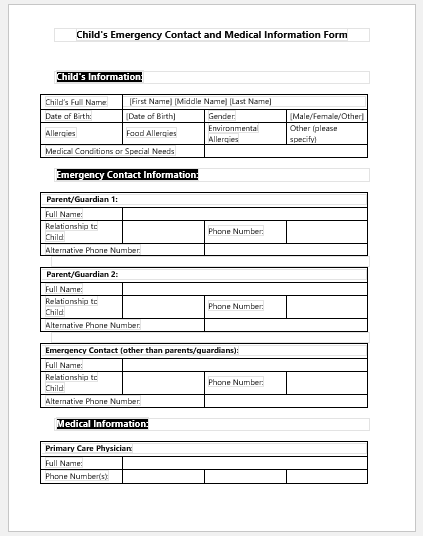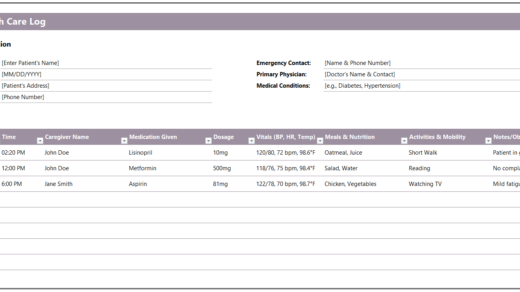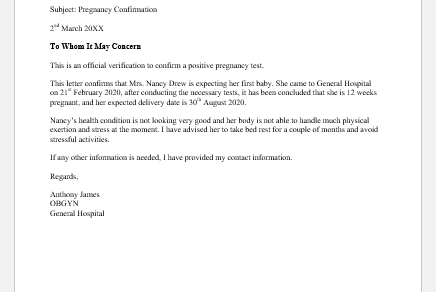A child’s emergency contact and medical information form is a document provided by parents to guarantee their child’s safety and well-being. The responsibility solely lies with the parents to ensure the information is accurate and updated. It can be the difference between life and death in an emergency. It is imperative to have a child’s emergency contact information and medical information form completed and easily available.
Contents of the form
A child’s emergency contact and medical information form should include the following information:
- child’s full name
- Date of birth
- Allergies (food, medication, insect bites, etc.)
- Medications the child is currently taking.
- Chronic conditions (asthma, diabetes, epilepsy, etc.)
- Doctor’s name and contact information.
- Emergency contact name and phone number (in case parents can’t be reached)
- Insurance information
- Blood type (if known)
[Template]

The Form File: 38 KB
Use Cases
A medical information form for a child is helpful in a variety of situations. For a child’s safety and well-being, this information should be provided beforehand to the school, daycare facility, or summer camp the child attends. Teachers, caretakers, camp counselors, and anyone attending to the children, must be aware of any medical conditions or allergies that may necessitate urgent attention for a child.
Furthermore, for participation in sports or other physical activities, coaches and trainers must be conscious of any medical conditions that may impair a child’s performance or place them at risk of injury. Similarly, suppose parents or guardians do not accompany a child on a journey or vacation. In that case, the child’s emergency contact information and medical information form should be provided to the responsible adult.
Importance of using the form
In an emergency, having a child’s emergency contact and medical information form completed and accessible can mean the difference between life and death. If a kid suffers from a severe allergic reaction or an asthma attack, caregivers attending to children must know what to do to keep them secure. They can provide the help the child needs if they have the expertise, or they can call the parents and inform them about the child’s situation.
An updated and accurate emergency contact and medical information form for a child can assist doctors and medical professionals in making informed decisions about a child’s treatment. Accessibility to this information is especially imperative for children suffering from a chronic condition, such as diabetes or epilepsy. Physicians attending to the child must be aware of the medications they are taking as well as their usual blood sugar levels or seizure patterns.
Conclusion
To summarize, a child’s emergency contact and medical information form is an important document that all parents should have completed and easily available. This form contains vital health information about your kid that can assist caregivers, teachers, coaches, and medical professionals in making informed choices in an emergency.
Having this form available with accurate and updated information can help guarantee a child’s safety and well-being.
- Nursing Documentation Templates
- Mental Health Evaluation Forms
- Forms Used by Pediatricians
- Various Forms Related to Pregnancy Verification
- Common Forms Used by ENT Specialists
- Pain Diary Worksheet Template
- Forms Commonly Used by Old Age Homes
- Medical Treatment Consent Form
- Home Exercise Program Worksheet
- Forms Used for Mental Health Assessment
- Forms Used by Psychologists
- Medical Forms Commonly Used by/for Students
- Assessment Consent Form
- Forms Used by an Anesthesiologist
- Not Fit to Fly Certificate Template


